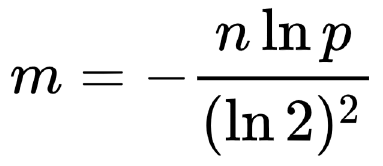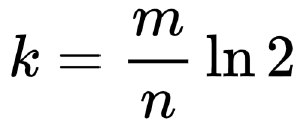布隆过滤器(Bloom Filter)
数据结构与算法笔记:恋上数据结构笔记目录
引出布隆过滤器(判断元素是否存在)
思考:如果要经常判断 1 个元素是否存在,要怎么做?
- 很容易想到使用哈希表(
HashSet、HashMap),将元素作为 key 去查找
时间复杂度:O(1),但是空间利用率不高,需要占用比较多的内存资源
如果需要编写一个网络爬虫去爬10亿个网站数据,为了避免爬到重复的网站,如何判断某个网站是否爬过?
- 很显然,
HashSet、HashMap并不是非常好的选择
是否存在时间复杂度低、占用内存较少的数据结构 ?
- 布隆过滤器(Bloom Filter)
布隆过滤器介绍(概率型数据结构)
1970年由布隆提出
- 它是一个空间效率高的概率型数据结构,可以用来告诉你:一个元素一定不存在或者可能存在。
优缺点:
- 优点:空间效率和查询时间都远远超过一般的算法
- 缺点:有一定的误判率、删除困难
布隆过滤器实质上是一个很长的二进制向量和一系列随机映射函数(Hash函数);
常见应用:
- 网页黑名单系统
- 垃圾邮件过滤系统
- 爬虫的网址判重系统
- 解决缓存穿透问题(后端开发)
布隆过滤器的原理(二进制 + 哈希函数)
假设布隆过滤器由 20位二进制、 3个哈希函数组成,每个元素经过哈希函数处理都能生成一个索引位置。

布隆过滤器的基础操作有两个:添加、查询
- 添加元素:将每一个哈希函数生成的索引位置都设为 1
- 查询元素是否存在:
如果有一个哈希函数生成的索引位置不为 1,就代表不存在(100%准确)
如果每一个哈希函数生成的索引位置都为 1,就代表存在(存在一定的误判率)

- 添加、查询的时间复杂度都是:O(k) ,k 是哈希函数的个数
- 空间复杂度是:O(m) ,m 是二进制位的个数
布隆过滤器的误判率(公式)
误判率 p 受 3 个因素影响:二进制位的个数 m、哈希函数的个数 k、数据规模 n。
误判率 p 的公式:

已知误判率 p、数据规模 n,求二进制位的个数 m、哈希函数的个数 k:
- 二进制位的个数 m:

- 哈希函数的个数 k:

布隆过滤器的实现
Guava: Google Core Libraries For Java(谷歌核心库中Java实现)
布隆过滤器的基础操作有两个:添加元素、查询元素是否存在
/**
* 添加元素
* @return true代表bit发送了变化
*/
boolean put(T value);
/**
* 查询元素是否存在
* @return false代表一定不存在, true代表可能存在
*/
boolean contains(T value);
布隆过滤器的构造
根据上面的公式可知,布隆过滤器必然有2个全局变量:
bitSize:二进制向量的长度(一共有多少个二进制位)hashSize:哈希函数的个数
并且必然有个容器来存储这些二进制位:
bits:这里选择long[]来存储,因为1个long可以表示64位bit;(int[]等数组也可以)
package com.mj;
public class BloomFilter<T> {
/**
* 二进制向量的长度(一共有多少个二进制位)
*/
private int bitSize;
/**
* 二进制向量
*/
private long[] bits;
/**
* 哈希函数的个数
*/
private int hashSize;
/**
* 布隆过滤器的构造
* @param n 数据规模
* @param p 误判率, 取值范围(0, 1)
*/
public BloomFilter(int n, double p){
if (n <= 0 || p <= 0 || p >= 1) { // 非法输入检测
throw new IllegalArgumentException("wrong n or p");
}
// 根据公式求出对应的数据
double ln2 = Math.log(2);
// 求出二进制向量的长度
bitSize = (int) (- (n * Math.log(p)) / (ln2 * ln2));
hashSize = (int) (bitSize * ln2 / n);
// bits数组的长度
bits = new long[(bitSize + Long.SIZE - 1) / Long.SIZE]; // 分页公式
// (64 + 64 - 1) / 64 = 127 / 64 = 1
// (128 + 64 - 1) / 64 = 2
// (130 + 64 - 1) / 64 = 3
// 分页问题:
// 每一页显示100条数据, pageSize = 100
// 一共有999999条数据, n = 999999
// 请问有多少页 pageCount = (n + pageSize - 1) / pageSize
};
}
测试一下,假设有1亿个数据,要求误判率为1%:
可以得到哈希函数的个数为 6,二进制位的个数是 958505837。
public static void main(String[] args) {
BloomFilter<Integer> bf = new BloomFilter<>(1_0000_0000, 0.01);
// 哈希函数的个数: 6
// 二进制位的个数: 958505837
}
布隆过滤器 - 添加元素
设置指定位置元素的二进制值为1
比如要设置 100000 的 第2位bit 为 1,应当 100000 | 000100,即 100000 | (1 << 2);
100000
| 000100 == (1 << 2)
------------------
100100
那么设置 value 的 第index位bit为 1,则是 value| (1 << index);
/**
* 设置index位置的二进制为1
*/
private boolean set(int index){
// 对应的long值
long value = bits[index / Long.SIZE];
int bitValue = 1 << (index % Long.SIZE);
bits[index / Long.SIZE] = value | bitValue;
return (value & bitValue) == 0;
}
有了以上基础,可以实现布隆过滤器的添加元素操作:
/**
* 添加元素
*/
public boolean put(T value) {
nullCheck(value);
// 利用value生成 2 个整数
int hash1 = value.hashCode();
int hash2 = hash1 >>> 16;
boolean result = false;
for (int i = 1; i <= hashSize; i++) {
int combinedHash = hash1 + (i * hash2);
if (combinedHash < 0) {
combinedHash = ~combinedHash;
}
// 生成一个二进制的索引
int index = combinedHash % bitSize;
// 设置第index位置的二进制为1
if (set(index)) result = true;
// 101010101010010101
// | 000000000000000100 1 << index
// 101010111010010101
}
return result;
}
布隆过滤器 - 判断元素是否存在
查看指定位置的二进制的值
比如要查看 10101111 的 第2位bit 为 1,应当 10101111 & 00000100,即 10101111 & (1 << 2),只有指定位置的二进制的值为 0,返回值才会是 0,否则为 1;
10101111
& 00000100 == (1 << 2)
--------------
00000100 != 0, 说明index位的二进制为1
那么获取 value 的 第index位bit 的值,则是 value & (1 << index);
/**
* 查看index位置的二进制的值
* @param index
* @return true代表1, false代表0
*/
private boolean get(int index) {
// 对应的long值
long value = bits[index / Long.SIZE];
return (value & (1 << (index % Long.SIZE))) != 0;
}
有了以上基础,可以实现布隆过滤器的判断一个元素是否存在操作:
/**
* 判断一个元素是否存在
*/
public boolean contains(T value) {
nullCheck(value);
// 利用value生成2个整数
int hash1 = value.hashCode();
int hash2 = hash1 >>> 16;
for (int i = 1; i <= hashSize; i++) {
int combinedHash = hash1 + (i * hash2);
if (combinedHash < 0) {
combinedHash = ~combinedHash;
}
// 生成一个二进制的索引
int index = combinedHash % bitSize;
// 查询第index位置的二进制是否为0
if (!get(index)) return false;
// 101010101010010101
// | 000000000000000100 1 << index
// 101010111010010101
}
return true;
}
布隆过滤器 - 完整代码
package com.mj;
public class BloomFilter<T> {
/**
* 二进制向量的长度(一共有多少个二进制位)
*/
private int bitSize;
/**
* 二进制向量
*/
private long[] bits;
/**
* 哈希函数的个数
*/
private int hashSize;
/**
* 布隆过滤器的构造
* @param n 数据规模
* @param p 误判率, 取值范围(0, 1)
*/
public BloomFilter(int n, double p){
if (n <= 0 || p <= 0 || p >= 1) { // 非法输入检测
throw new IllegalArgumentException("wrong n or p");
}
// 根据公式求出对应的数据
double ln2 = Math.log(2);
// 求出二进制向量的长度
bitSize = (int) (- (n * Math.log(p)) / (ln2 * ln2));
hashSize = (int) (bitSize * ln2 / n);
// bits数组的长度
bits = new long[(bitSize + Long.SIZE - 1) / Long.SIZE]; // 分页公式
// (64 + 64 - 1) / 64 = 127 / 64 = 1
// (128 + 64 - 1) / 64 = 2
// (130 + 64 - 1) / 64 = 3
// 分页问题:
// 每一页显示100条数据, pageSize = 100
// 一共有999999条数据, n = 999999
// 请问有多少页 pageCount = (n + pageSize - 1) / pageSize
};
/**
* 添加元素
*/
public boolean put(T value) {
nullCheck(value);
// 利用value生成2个整数
int hash1 = value.hashCode();
int hash2 = hash1 >>> 16;
boolean result = false;
for (int i = 1; i <= hashSize; i++) {
int combinedHash = hash1 + (i * hash2);
if (combinedHash < 0) {
combinedHash = ~combinedHash;
}
// 生成一个二进制的索引
int index = combinedHash % bitSize;
// 设置第index位置的二进制为1
if (set(index)) result = true;
// 101010101010010101
// | 000000000000000100 1 << index
// 101010111010010101
}
return result;
}
/**
* 判断一个元素是否存在
*/
public boolean contains(T value) {
nullCheck(value);
// 利用value生成2个整数
int hash1 = value.hashCode();
int hash2 = hash1 >>> 16;
for (int i = 1; i <= hashSize; i++) {
int combinedHash = hash1 + (i * hash2);
if (combinedHash < 0) {
combinedHash = ~combinedHash;
}
// 生成一个二进制的索引
int index = combinedHash % bitSize;
// 查询第index位置的二进制是否为0
if (!get(index)) return false;
// 101010101010010101
// | 000000000000000100 1 << index
// 101010111010010101
}
return true;
}
/**
* 设置index位置的二进制为1
*/
private boolean set(int index){
// 对应的long值
long value = bits[index / Long.SIZE];
int bitValue = 1 << (index % Long.SIZE);
bits[index / Long.SIZE] = value | bitValue;
return (value & bitValue) == 0;
/*
* 100000
* | 000100 1 << 2
* ---------
* 100100
*/
}
/**
* 查看index位置的二进制的值
* @param index
* @return true代表1, false代表0
*/
private boolean get(int index) {
// 对应的long值
long value = bits[index / Long.SIZE];
return (value & (1 << (index % Long.SIZE))) != 0;
/*
* 10101111
* & 00000100
* -----------
* 00000100 != 0, 说明index位的二进制为1
*/
}
private void nullCheck(T value) {
if (value == null) {
throw new IllegalArgumentException("Value must not be null.");
}
}
}
测试:
public static void main(String[] args) {
BloomFilter<Integer> bf = new BloomFilter<>(1_00_0000, 0.01);
for (int i = 1; i <= 1_00_0000; i++) {
bf.put(i);
}
// for (int i = 1; i <= 1_00_0000; i++) {
// System.out.println(bf.contains(i));
// }
// 测试 1000000 条数据中的误判数
int count = 0;
for (int i = 1_00_0001; i <= 2_00_0000; i++) {
if (bf.contains(i)){
count++;
}
}
System.out.println(count); // 20
}
10亿网站爬虫问题
回到一开始的问题:如果需要编写一个网络爬虫去爬10亿个网站数据,为了避免爬到重复的网站,如何判断某个网站是否爬过?
该问题的代码的大体框架如下:
// url数组
String[] urls = {};
BloomFilter<String> bf = new BloomFilter<>(10_0000_0000, 0.01);
for (String url : urls) {
if (bf.contains(url)) continue;
// 爬这个url
// ......
// 爬完该url, 放进BloomFilter中
bf.put(url);
}
根据布隆过滤器的原理:依靠哈希函数产生的索引,找到对应的二进制位值,为 1 则已经存在(存在误判),否则不存在(100%精确)。
bf.contains(url) ,如果已经爬过的网址在布隆过滤器中,必然会返回 true,因此可以保证不会重复爬。但是有些网址可能没有爬过,但是经过哈希冲突,使得bf.contains(url) 返回也为 true,可知有几率漏爬。
可以确保,这么写不会重复爬,但是有几率漏爬。
下面这种写法也可以:同样保证不重复爬,有几率漏爬。
String[] urls = {};
BloomFilter<String> bf = new BloomFilter<>(10_0000_0000, 0.01);
for (String url : urls) {
if (bf.put(url) == false) continue;
// 爬这个url
// ......
}
bf.put(url) 如果遇到已经在布隆过滤器中的元素,必然返回 false,可以保证不重复爬。但是有些网址没有爬过,经过哈希冲突,使得 bf.put(url) 返回了 flase,有几率漏爬。